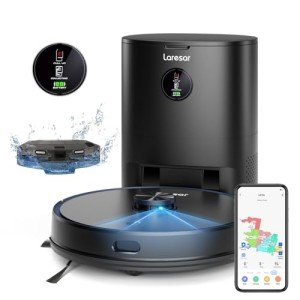
Robotic Vacuum Cleaner UK
Add a review FollowOverview
-
Founded Date 28 September 1920
-
Sectors Sales & Marketing
-
Posted Jobs 0
-
Viewed 32
Company Description
Why Vacuum Mop Cleaner Robot Is Fast Increasing To Be The Hot Trend For 2024
The Rise of the Robot Cleaner: Exploring the World of Vacuum Mop Cleaner Robots
In today’s fast-paced world, the need for convenience and efficiency in household chores is higher than ever. Amidst the stress of every day life, finding time for extensive cleaning can seem like a luxury. This is where the innovative world of vacuum mop cleaner robots actions in, using a helping hand in preserving pristine floors with very little effort. These innovative gadgets are no longer a futuristic dream however a tangible truth, quickly ending up being a staple in contemporary homes. By integrating the functions of vacuuming and mopping into a single, automatic system, these robots guarantee to transform home cleaning, allowing people to reclaim their valuable time and enjoy consistently tidy home.

Vacuum mop cleaner robots represent a substantial leap forward in home automation. They are smart, self-navigating gadgets created to autonomously clean floors, dealing with both dust, particles, and spills with exceptional ease. These robots are not simply upgraded vacuum; they are sophisticated cleaning systems equipped with advanced sensing units, intelligent algorithms, and dual cleaning mechanisms to supply a detailed floor cleaning solution. As innovation continues to advance and rates become more available, the appeal of these robotic helpers is just set to grow, promising a future where sparkling tidy floorings are easily preserved by our automated allies. This post will delve into the world of vacuum mop cleaner robotics, exploring their performance, benefits, types, essential considerations when selecting one, and what the future holds for these progressively popular family companions.
How Vacuum Mop Cleaner Robots Work: A Symphony of Technology
The magic behind vacuum mop cleaner robotics depends on their intricate blend of hardware and software. These gadgets seamlessly incorporate vacuuming and mopping capabilities, operating autonomously to provide an extensive cleaning experience. Comprehending their inner functions is important to appreciating their effectiveness and selecting the best model for particular requirements.
At their core, vacuum mop cleaner robotics use a combination of technologies to browse and tidy efficiently. Here’s a breakdown of their essential functional parts:
-
Navigation and Mapping: Modern robot vacuum mops use sophisticated navigation systems to understand and map their cleaning environment. Lots of high-end designs utilize LiDAR (Light Detection and Ranging) technology, which utilizes lasers to develop a comprehensive map of the space. This permits effective cleaning paths, organized room protection, and challenge avoidance. Other robotics may use camera-based visual SLAM (Simultaneous Localization and Mapping) or rely on infrared sensors and gyroscopes for navigation. Simpler designs may utilize a more random or bounce-based navigation system, which, while less efficient, still does the job gradually.
-
Vacuuming System: The vacuuming function is usually powered by a motor that creates suction. This suction, integrated with rotating brushes below the robot, lifts dust, dirt, pet hair, and other debris from the floor. Gathered debris is then transported into an internal dustbin. The suction power and brush design can vary between models, influencing their effectiveness on various floor types and in getting various types of dirt.
-
Mopping System: This is where vacuum mop robots genuinely differentiate themselves. They are geared up with a water tank and a mopping pad. Water is given onto the pad, which is then dragged or turned throughout the floor surface area. Different models make use of numerous mopping systems:
- Dragging Mop Pads: These are the simplest and most typical. The robot drags a damp microfiber pad across the floor.
- Vibrating Mop Pads: Some robots include vibrating mop pads that scrub the floor better, loosening up harder discolorations and grime.
- Turning Mop Pads: More innovative designs utilize turning mop pads that simulate manual mopping actions, providing a much deeper clean and better stain elimination capabilities.
- Sonic Mopping: Premium robotics integrate sonic vibration technology, creating high-frequency vibrations in the mopping pad for extremely effective scrubbing.
-
Sensing units and Intelligence: A variety of sensing units are vital for robot operation. Cliff sensors prevent robotics from falling down stairs. Bump sensors spot challenges. Wall sensors permit for edge cleaning. The robot’s software application and algorithms procedure sensing unit data to make smart choices about cleaning paths, obstacle avoidance, and returning to the charging dock when the battery is low or cleaning is complete. Numerous robotics now use smartphone app integration, enabling functions like scheduling, zone cleaning, and real-time tracking.
The Plethora of Perks: Why Choose a Vacuum Mop Robot?
The popularity of vacuum mop cleaner robotics is not just a passing trend; it is rooted in the concrete benefits they provide to modern families. Investing in one of these devices can considerably enhance your quality of life and home environment in numerous ways:
-
Time and Effort Savings: This is possibly the most compelling benefit. Robot vacuum mops automate a time-consuming task, freeing up your important time to concentrate on other top priorities, whether it’s work, family, hobbies, or just relaxation.
-
Consistent Cleanliness: Unlike manual cleaning which may be sporadic, robots can be configured to tidy everyday or even several times a day, ensuring consistently tidy floors and a healthier living environment.
-
Reaching Under Furniture: Their low profile enables robots to easily browse under furnishings like beds, sofas, and cabinets, areas that are frequently tough to reach with standard vacuums and mops.
-
Arranged Cleaning: With app control and scheduling features, you can set the robot to clean up at particular times, even when you’re not home. Think of coming home to freshly cleaned floors every day without raising a finger!
-
Improved Air Quality: By frequently vacuuming and eliminating dust and allergens from floorings, robot vacuum mops contribute to improved indoor air quality, which can be particularly helpful for people with allergies or breathing sensitivities.
-
Lowered Physical Strain: For individuals with mobility concerns, back problems, or merely those who discover vacuuming and mopping physically demanding, a robot cleaner offers a welcome reprieve, eliminating the need for difficult exercise.
-
Pet Hair Management: Robot vacuum mops are especially effective at taking on pet hair, a common home nuisance for pet owners. Routine cleaning reduces pet dander and keeps homes cleaner and more hygienic for both pets and their owners.
Navigating the marketplace: Types of Vacuum Mop Robots
The market for vacuum mop cleaner robotics varies, with various designs dealing with various requirements and budgets. Understanding the various types can help you make an educated option:
-
2-in-1 Vacuum and Mop Robots: These are the most common type, integrating both vacuuming and mopping functionalities in a single system. They normally switch in between modes or run both simultaneously depending on the design.
-
Devoted Vacuum Robots with Mopping Attachment: Some robotics are mainly designed for vacuuming however use a removable mopping module. These may be an excellent option for those who focus on strong vacuuming abilities however want periodic mopping performance.
-
Dry Mopping vs. Wet Mopping Robots: While virtually all “mop” robots offer wet mopping to some extent, some are better matched for mostly dry sweeping and light moist mopping for dust elimination. Others are designed for more robust damp mopping with functions like adjustable water flow and scrubbing pads.
-
Navigation Technology Based Classification:
- LiDAR Navigation Robots: Offer the most accurate navigation, efficient cleaning courses, and advanced functions like room mapping, zone cleaning, and no-go zones.
- Camera-Based Navigation Robots: Use visual SLAM for mapping and navigation, frequently offering great coverage and item recognition.
- Infrared and Gyroscope Navigation Robots: More economical alternatives that use sensors and gyroscopes for navigation, generally less systematic and efficient than LiDAR or camera-based systems.
- Random/Bounce Navigation Robots: Basic designs that move arbitrarily, altering direction upon coming across challenges. While less effective, they can still clean up efficiently over time, especially in smaller sized areas.
-
Feature-Based Classification:
- Self-Emptying Robots: These robotics instantly empty their dustbins into a bigger base station, significantly lowering upkeep frequency.
- App-Controlled Robots: Offer mobile phone app combination for scheduling, remote control, zone cleaning, real-time mapping, and more.
- Smart Home Integration Robots: Compatible with voice assistants like Alexa or Google Assistant, permitting voice-activated cleaning commands and automation within smart home communities.
Secret Considerations: Choosing the Right Robot for Your Home
With a broad array of choices available, selecting the right vacuum mop robot needs careful consideration of your particular needs and home environment. Here are some key factors to evaluate:
- Floor Type Compatibility: Consider the types of flooring in your home. Some robots perform much better on tough floors, while others are designed to deal with carpets and rugs successfully. Look for brush type and suction power suitability for your floor surfaces.
- Suction Power: Higher suction power is normally much better for selecting up pet hair, ingrained dirt, and particles from carpets and carpets. For mainly hard floorings, moderate suction might be enough.
- Mopping Effectiveness: Evaluate the mopping system. Think about whether you need light moist mopping for dust elimination or more robust wet mopping for stain removal. Features like vibrating or rotating mop pads improve mopping performance.
- Battery Life and Coverage Area: Ensure the robot’s battery life and protection area are adequate for cleaning your whole home in a single charge. Examine the maker’s specs and consider your home’s size.
- Navigation and Mapping System: For bigger homes or those with complex layouts and multiple spaces, LiDAR or camera-based navigation is highly recommended for efficient cleaning and systematic protection.
- Functions: Consider desired features like app control, scheduling, zone cleaning, no-go zones, self-emptying, and smart home combination based upon your way of life and preferences.
- Maintenance Requirements: Think about the maintenance involved. Self-emptying robotics decrease dustbin emptying frequency. Evaluate the ease of cleaning brushes, replacing filters, and preserving mopping pads.
- Spending plan: Robot vacuum mops vary in price from budget-friendly to premium. Determine your budget plan and prioritize features that are essential to you.
Keeping Your Robot Running Smoothly: Maintenance and Care
To ensure your vacuum mop robot continues to carry out optimally and enjoys a long lifespan, regular maintenance is necessary. Basic maintenance tasks can significantly impact its efficiency and durability:
- Empty the Dustbin Regularly: This is important for preserving suction power. Empty the dustbin after each cleaning cycle or as regularly as recommended by the manufacturer. For self-emptying robotics, make sure the base station dustbin is likewise cleared occasionally.
- Tidy the Brushes: Hair, threads, and particles can get tangled in the brushes. Routinely get rid of and clean up the brushes to maintain their efficiency. Some robotics include cleaning tools specifically developed for this purpose.
- Clean or Replace Filters: Filters trap dust and irritants. Routinely clean or change filters as per the producer’s directions to preserve excellent air quality and suction.
- Clean the Mopping Pads: Wash or change mopping pads frequently to preserve health and mopping efficiency. Follow the manufacturer’s standards for cleaning or replacing pads.
- Inspect and Clean Sensors: Sensors are important for navigation. Periodically clean sensing units with a soft, dry cloth to ensure they are devoid of dust and particles, keeping accurate navigation.
- Maintain Water Tank (if appropriate): For robotics with water tanks, frequently clean the tank and guarantee it is without mineral buildup. Usage distilled water if advised by the maker to avoid mineral deposits.
- Software Updates: If your robot is app-controlled, keep the robot’s firmware and app upgraded to take advantage of performance enhancements and brand-new functions.
The Future is Automated: Looking Ahead for Vacuum Mop Robots
The development of vacuum mop cleaner robotics is far from over. The future holds exciting possibilities and advancements poised to even more boost their capabilities and integration into our lives:
- Enhanced AI and Smart Features: Expect more sophisticated AI combination for enhanced things recognition, challenge avoidance, and individualized cleaning routines based on learning your home layout and cleaning preferences.
- Enhanced Navigation and Mapping: Navigation systems will end up being much more accurate, effective, and adaptable to vibrant home environments. Robotics might discover to browse around moving barriers and adjust to modifications in furnishings placement.
- More Powerful and Versatile Cleaning: Suction power and mopping efficiency will continue to enhance, enabling robots to deal with even tougher cleaning obstacles and various floor types with higher performance.
- Integration with Smart Home Ecosystems: Seamless integration with broader smart home communities will end up being more widespread, enabling for more sophisticated automation circumstances and voice control abilities.
- Self-Cleaning and Self-Maintenance: Future robots may integrate self-cleaning features for brushes and mopping pads, even more minimizing upkeep problem.
In Conclusion:
Vacuum mop cleaner robots are no longer a futuristic novelty but an important and practical addition to the modern home. They use a compelling solution for busy people and households seeking to keep tidy floorings with very little effort. By understanding their functionality, advantages, types, and essential considerations, you can make a notified choice and select a robot that perfectly complements your lifestyle and cleaning requirements. As technology continues to advance, these automated cleaning buddies will just become more intelligent, efficient, and indispensable in our quest for cleaner, healthier, and easier living areas.
Often Asked Questions (FAQs) about Vacuum Mop Cleaner Robots
Q: Are vacuum mop cleaner robots worth the cash?A: For numerous, the response is yes. The time and effort conserved, integrated with consistently tidy floors and the convenience of automated cleaning, typically outweigh the preliminary financial investment. Consider your way of life and how much you value your time and tidiness when making this choice.
Q: Can robot vacuum mops change regular vacuums and mops totally?A: For daily cleaning and upkeep, they can considerably minimize or even eliminate the need for traditional vacuums and mops. Nevertheless, for deep cleaning, tackling large spills, or cleaning upholstery and other surface areas, you may still need a conventional vacuum or mop.
Q: Do robot vacuum mops work on all floor types?A: Most contemporary robotics work well on tough floors like tile, wood, laminate, and vinyl. Lots of can also deal with low-pile carpets and rugs. However, extremely thick carpets or shag carpets might pose difficulties for some designs. Always check the manufacturer’s specifications for floor type compatibility.
Q: What kind of upkeep is needed for a vacuum mop robot?A: Regular upkeep includes emptying the dustbin, cleaning brushes, cleaning or changing filters, cleaning mopping pads, and regularly cleaning sensors. Upkeep frequency varies depending on usage and the particular design.
Q: How long do vacuum mop robots normally last?A: The life-span of a robot vacuum mop depends upon use, maintenance, and develop quality. Usually, with proper care, a great quality robot can last for several years (3-5 years or more). Battery life may break down over time and might eventually require replacement.
Q: Are vacuum mop robotics safe for animals and kids?A: Generally, yes. They are designed to browse around barriers. Nevertheless, it’s constantly prudent to supervise animals and little kids initially to guarantee they don’t hinder the robot’s operation or vice versa. Keep small things and cables out of the robot’s path to avoid entanglement.
Q: Can robot vacuum mops climb up stairs?A: No, the majority of robot vacuum mops are designed for single-level cleaning. They are geared up with cliff sensors to avoid them from falling down stairs, however they can not climb stairs themselves. For multi-level homes, you would generally need a robot for each level or by hand move the robot between floorings.

Q: How noisy are vacuum mop robotics?A: Noise levels differ between models. Generally, they are quieter than traditional vacuum. Lots of run at a sound level similar to a peaceful discussion. Some models offer a “peaceful mode” for even quieter operation.
Q: Can I utilize cleaning options in the water tank of a robot mop?A: It is vital to examine the producer’s recommendations. Some robotics are created to only use plain water in the water tank. Utilizing particular cleaning solutions can harm the robot or void the guarantee. If enabled, utilize only mild, diluted cleaning services specifically approved for robot mops.



